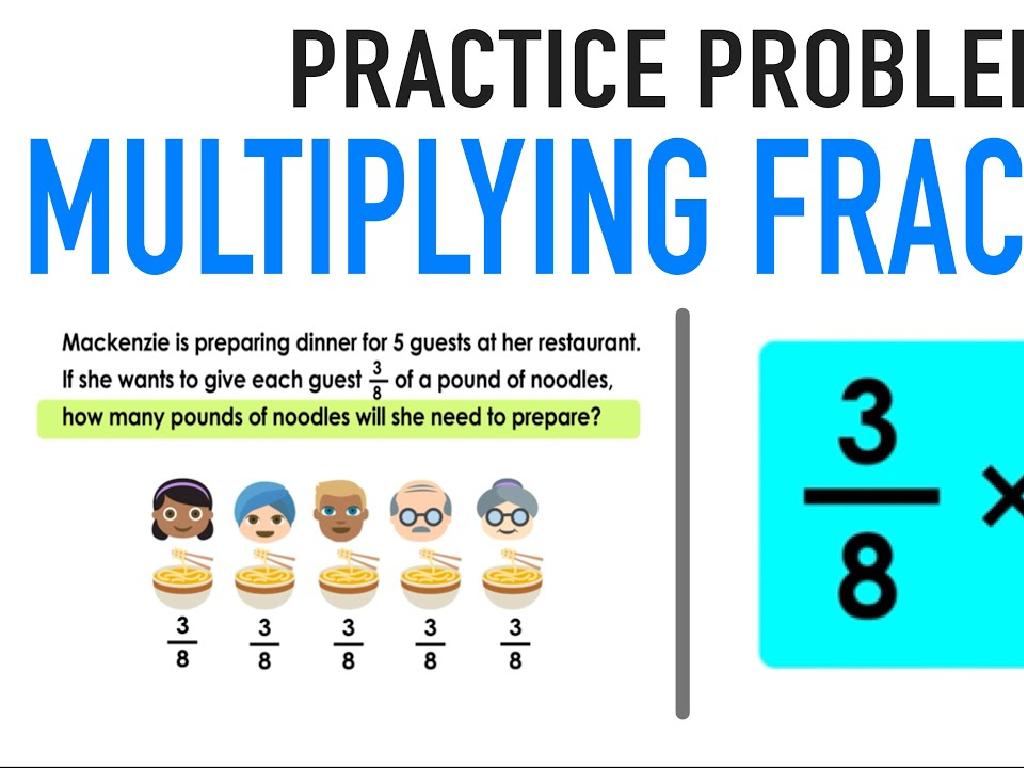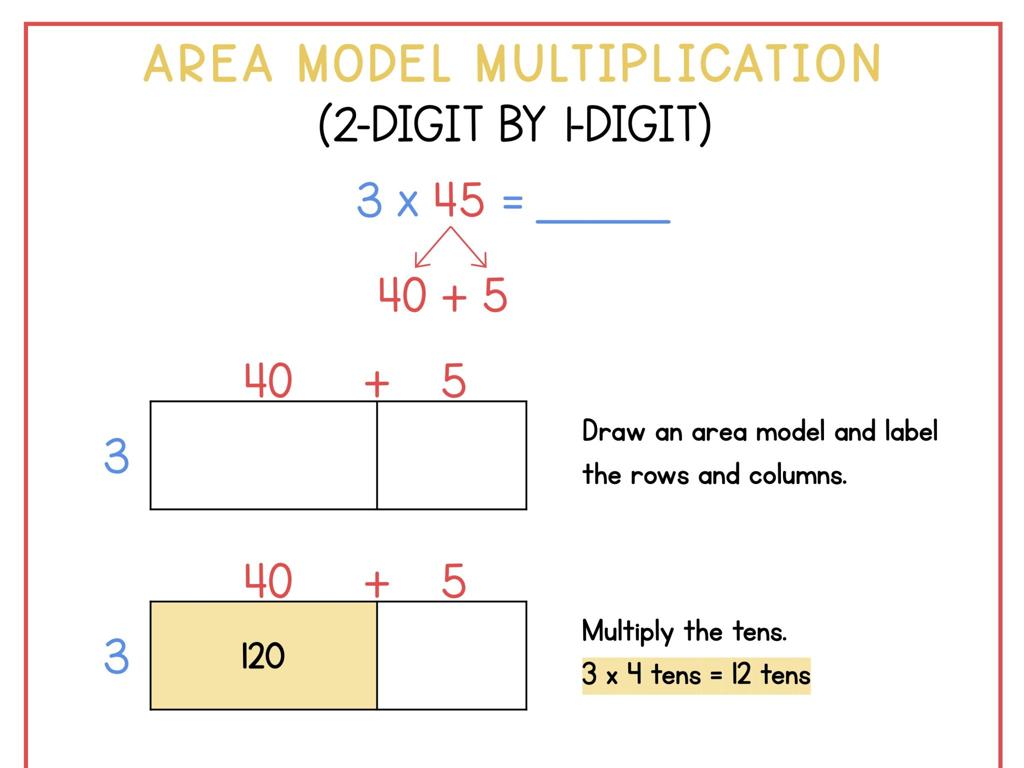Estimate Products Of Decimals
Subject: Math
Grade: Fifth grade
Topic: Multiply Decimals
Please LOG IN to download the presentation. Access is available to registered users only.
View More Content
Welcome to Multiplying Decimals!
– Greet and introduce today’s topic
– Review the concept of decimals
– Decimals represent parts of a whole
– Why estimate decimal products?
– Estimation helps in quick & practical calculations
– Real-life application of estimation
– Useful in budgeting, shopping, and measurements
|
Begin the class with a warm welcome and introduce the topic of multiplying decimals, aiming to create an engaging and comfortable learning environment. Review the concept of decimals by reminding students that decimals are fractions written in a special form to represent parts of a whole. Emphasize the importance of estimating products of decimals in everyday life, such as making quick calculations when shopping or budgeting. Highlight how estimation is a valuable skill that can save time and effort. Provide examples such as estimating the total cost of items in a shopping cart or materials needed for a project. Encourage students to think of other scenarios where they could apply estimation with decimals.
Understanding Estimation with Decimals
– What is estimation?
– Estimation is finding a number close to the exact amount.
– Exact vs. Estimated answers
– Exact answers are precise, estimates are close guesses.
– When to use estimation
– Use estimation to check math or when an exact number isn’t needed.
– Examples of estimation
– Estimating costs when shopping or during quick calculations.
|
This slide introduces the concept of estimation, which is a critical skill in mathematics, especially when dealing with decimals. Estimation helps students to quickly find an answer that is close enough to the exact value, which can be useful in many real-life situations. It’s important to differentiate between exact answers and estimates, as this will help students understand when it is appropriate to use each. Provide examples such as estimating the total cost while shopping or making quick calculations in their heads to demonstrate the usefulness of estimation in everyday life. Encourage students to practice by rounding decimals to the nearest whole number and then multiplying to estimate the product.
Rounding Decimals to Estimate Products
– Review rounding to whole numbers
– Rounding helps simplify numbers for easier calculation.
– Practice with example decimals
– Let’s round 4.67 to 5 and 3.14 to 3.
– Connect rounding to estimation
– Rounding makes it quicker to estimate the result of multiplication.
– Simplify multiplication
|
Begin by reviewing the concept of rounding decimals to the nearest whole number, ensuring students recall the rules (if the decimal is 0.5 or above, round up). Provide a few examples for the class to round together, such as 4.67 and 3.14. Explain that rounding is a useful skill for estimating the products of decimals because it simplifies the numbers, making mental math more manageable. Emphasize that while the exact answer isn’t achieved through estimation, it provides a close approximation that is often sufficient for everyday purposes. Encourage students to practice this skill to improve their speed and confidence in estimating products of decimals.
Multiplying Whole Numbers Review
– Review: Multiplying whole numbers
– Quick recap of how to multiply numbers like 3 x 4
– Solve a problem as a class
– Let’s multiply 25 x 64 together on the board
– Understand multiplication steps
– Break down the problem into simpler steps
– Relate to decimal multiplication
|
Begin with a quick review of multiplying whole numbers to ensure a solid foundation before moving on to decimals. Work through a multiplication problem as a class to demonstrate the process, breaking it down into manageable steps. Emphasize the importance of understanding each step, as this knowledge will be crucial when they begin to multiply decimals. Relate the process back to decimal multiplication to show the connection between the concepts. This will help students feel more confident as they approach more complex problems involving decimals.
Estimating Products of Decimals
– Learn to estimate decimal products
– Approximate the result of multiplying decimals
– Use rounding to simplify calculation
– Round decimals to nearest whole number before multiplying
– Class example: Estimate 4.81 x 3.47
– Round 4.81 to 5 and 3.47 to 3, then multiply
– Practice estimation with more examples
– Apply the same method to different decimal pairs
|
This slide introduces the concept of estimating the product of two decimals, which is a useful skill for making quick calculations. Start by explaining the importance of estimation and how it can be applied in real-life situations. Demonstrate the process by rounding each decimal to the nearest whole number, then multiplying the rounded numbers together. Work through the example provided as a class to ensure understanding. Encourage students to participate by rounding and multiplying together. Afterward, provide additional decimal pairs for students to practice estimation independently or in small groups.
Estimating Decimal Products
– Solve practice problems
– Estimate before multiplying
– Round decimals, then multiply to estimate
– Teacher checks understanding
– Share solutions with the class
– Discuss different estimation strategies used
|
This slide is designed to engage students in hands-on practice with estimating the products of decimals. Provide a set of problems that vary in difficulty to cater to the diverse skill levels within the class. Encourage students to round the decimals to the nearest whole number or tenths place before multiplying to make estimation easier. As students work, walk around the classroom to offer assistance and check for understanding, ensuring that each student is comfortable with the estimation process. Afterward, invite students to share their solutions and the strategies they used to estimate, fostering a collaborative learning environment.
Estimating Decimal Products in Real Life
– Present a real-world decimal problem
– Example: Estimating total cost of pencils at $0.79 each for a class set of 25.
– Class solves the problem together
– Use rounding to estimate: $0.79 H $0.80, $0.80 x 25 = $20.00.
– Discuss everyday usefulness
– Useful for quick budgeting, shopping, and planning.
– Practice with more examples
|
Introduce a relatable problem such as estimating the cost of school supplies. Guide the class through the process of rounding decimals to make estimation easier. Emphasize the importance of estimation for making quick decisions without calculators, such as when shopping or budgeting. After solving the initial problem, provide additional examples for the class to work on in groups or individually to reinforce the concept.
Class Activity: Estimation Station
– Divide into small groups
– Receive decimal multiplication problems
– Practice estimating products
– Round decimals, then multiply to estimate
– Compare estimates with actual results
– Discuss how close estimates were to actual answers
|
This interactive activity is designed to help students understand the concept of estimating products of decimals. By working in small groups, students can collaborate and discuss strategies for rounding decimals and estimating the results before performing the actual multiplication. Provide each group with a set of problems that vary in difficulty to cater to different skill levels within the class. After the estimation and calculation, encourage groups to compare their estimated results with the actual multiplication outcomes and discuss any discrepancies. This will help them grasp the importance and practicality of estimation in real-world scenarios. Possible activities could include estimating costs in a mock shopping scenario, predicting sports statistics, or calculating time needed for tasks.
Review and Reflect: Estimating Decimal Products
– Recap today’s key points
– Share your learning takeaways
– What new insights about estimating decimals did you gain?
– Discuss challenges faced
– Were there any tricky parts in today’s lesson?
– Address any questions
|
This slide aims to consolidate the learning from the lesson on estimating products of decimals. Begin by summarizing the main points, such as rounding decimals and using estimation to multiply. Encourage students to reflect on what they’ve learned by sharing their insights, which reinforces their understanding. Open the floor for students to discuss any parts of the lesson they found challenging, and address these as a group. This discussion can provide valuable feedback on teaching effectiveness and student comprehension. Finally, answer any lingering questions to ensure clarity and readiness to move forward. This reflective activity not only solidifies knowledge but also promotes a collaborative learning environment.
Homework: Estimating Decimal Products
– Solve decimal estimation problems
– Explain your estimation steps
– Write down how you guessed the answer, step by step.
– Utilize available resources
– Use class notes, textbooks, and online videos for help.
– Homework due next class
|
This homework assignment is designed to reinforce the concept of estimating products of decimals. Students are tasked with solving problems that require them to estimate the result of multiplying decimal numbers. They should be encouraged to write a brief explanation of the steps they took to arrive at their estimation, which will help them internalize the process and allow you to assess their understanding. Remind them to refer to their class notes, the textbook, and any recommended online resources or videos if they need assistance. This will also teach them to be resourceful and independent learners. Collect the homework in the next class for review and provide feedback on their estimation techniques and explanations.






